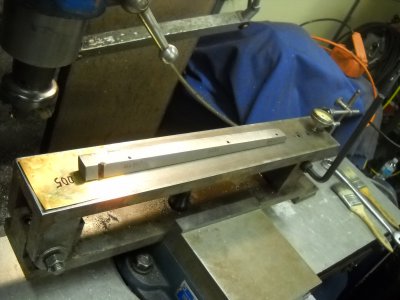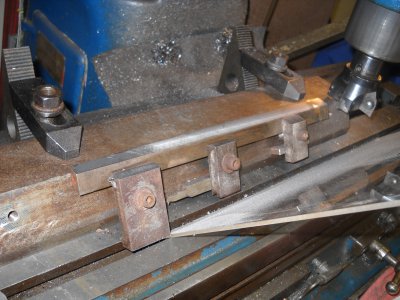Hello guys;
The original cross-slide gib on my Chinese 9 X 20 (yes, I know that these are not good machine tools, but it is what I have) is too narrow for the slot it fits into. So, I had ordered a piece of brass 3/8" thick and long and wide enough to machine the new gib from (I have a Taig mill). This is what the various forums recommend as gib material, but when machined this brass warps very badly. The result was a tapered length of brass strip with an obvious bow to it. I tried to straighten it with my press, but could only get it within 3 or 4 thou of straight and even then it is still tapered. So my adventure with trying brass for a gib went sour. So my questions are these:
1) what material do you guys suggest for a new gib?
2) how do you hold it flat while being milled? I have a tooling plate and can clamp from the edge, but there will be no down-pressure from
these clamps. Would I have to buy and use toe-clamps? (they are very expensive).
3) How to prevent warping with the next material that I try to make the gibs from? Would use of hot-rolled steel or leaded steel eliminate the
warping problem or is this something I am going to have to live with in trying to make the new gib?
Thanks in advance for any answers to my problem.
The original cross-slide gib on my Chinese 9 X 20 (yes, I know that these are not good machine tools, but it is what I have) is too narrow for the slot it fits into. So, I had ordered a piece of brass 3/8" thick and long and wide enough to machine the new gib from (I have a Taig mill). This is what the various forums recommend as gib material, but when machined this brass warps very badly. The result was a tapered length of brass strip with an obvious bow to it. I tried to straighten it with my press, but could only get it within 3 or 4 thou of straight and even then it is still tapered. So my adventure with trying brass for a gib went sour. So my questions are these:
1) what material do you guys suggest for a new gib?
2) how do you hold it flat while being milled? I have a tooling plate and can clamp from the edge, but there will be no down-pressure from
these clamps. Would I have to buy and use toe-clamps? (they are very expensive).
3) How to prevent warping with the next material that I try to make the gibs from? Would use of hot-rolled steel or leaded steel eliminate the
warping problem or is this something I am going to have to live with in trying to make the new gib?
Thanks in advance for any answers to my problem.



